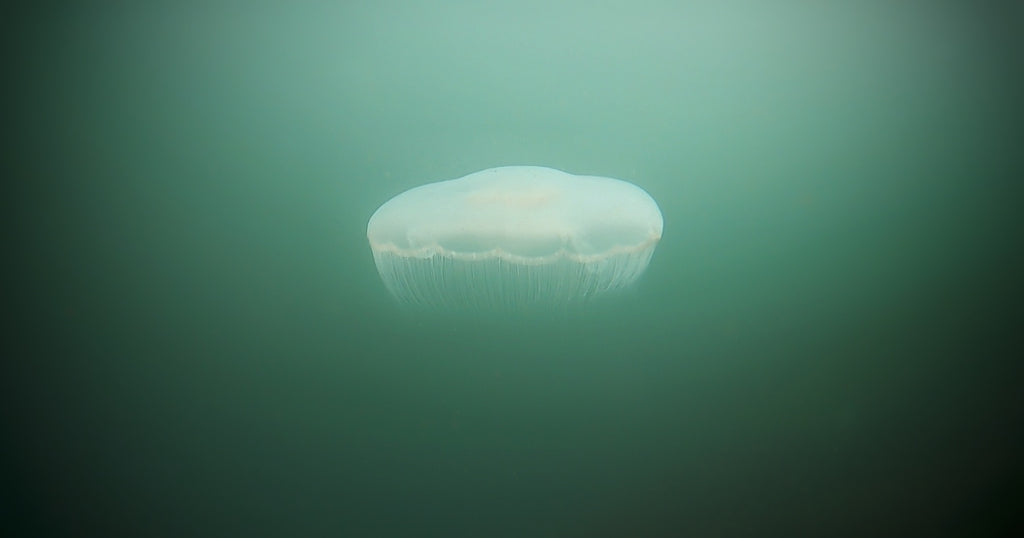I don a few layers of warm clothing—both top and bottom—and the warmest, tallest pair of socks I own. Next, I wriggle my way into my thick neoprene dry suit and get zipped up. Conlee is double checking the marine charts and slipping the tablet into a clear dry bag to use for enroute navigation. He grabs the handheld radio and hops down into the dinghy.
Muoi, our Siberian husky has already had her morning trip to shore and now sleeps peacefully under the cockpit cover as the rain pours down all around, hitting the foredeck like raindrops on a tin-roof.

I grab the first dive tank, with BCD (buoyancy control device) and regulator setup, and carefully hand it down to Conlee before grabbing the second. Next I pass along our weight belts, fins, masks, gloves, hoods, and dive flag, listing each item out loud and checking them off my mental checklist as we load. With the checklist complete, we are ready to go.
We have spent a fair bit of time perusing the marine charts and chosen a spot about a mile away with contour lines closely marked and what looks like a nice steep drop off. We attribute these contours to an underwater topographical feature resembling a rock wall, areas with potential for medium-high energy marine life below—where animals that thrive in systems with good oxygen and nutrient cycling tend to reside.

We tell Muoi to be a good dog and to watch over the boat before speeding off. Our 8hp outboard motor only goes about 4.5 knots under the heavy load and we’re happy to have our dry suits on as the rain pours and surface chop flies over the bow of the dinghy, straight into our faces. We are no strangers to a wet and wild ride after spending this winter on BC’s Northern coast, and we can’t help but laugh every time we clear our eyes of the cold saltwater.

Akhlut—our sailboat—does not exactly boast a lot of extra space, but the recent decision to purchase dive gear and a small portable compressor was an exciting move towards delving deeper into our environment. We have spent the last couple years getting more familiar with the water on which we sail, the weather that propels us, and the remote locations we travel to, yet this recently gained ability to explore the ‘foreign’ world below Akhlut’s hull has presented us with one of our greatest and most eye-opening adventures yet.
We throw our small 5lb dinghy anchor overboard when we reach the locale and wait a few minutes to make sure we aren’t drifting, then begin getting the rest of our gear on. I put on my weight belt—an extra 30lbs! —and check my air and gauges a second time before strapping on my BCD, tank and fins. Altogether I now carry nearly 90lbs of additional weight and I can feel it as I inch my bum closer to the edge of the dinghy, awkwardly shuffling myself into position. Conlee and I do our final buddy checks, add air into our BCDs and dry suits, and launch ourselves into the cold dark green water of the northern pacific. I immediately feel weightless.

We give each other the A-OK and begin our descent. At first everything around me is dark and I struggle to focus my eyes on the water that now envelops me. I can see the light of day disappearing as I drop into what appears to be an infinite abyss below. I see infinitesimal organisms suspended everywhere around me and the odd jelly drifting past me as I continue into the depths.

Everything I had on my mind in the world above has been replaced by the peace and quiet of this unfamiliar realm. I concentrate on my breath as I inhale and exhale, slowly settling into a mindful meditation.
Gradually my eyes adjust, and ambient light begins to reappear, silhouetting the large, irregularly worn rock beside me. The rock is elaborately encrusted with pink coralline algae, orange cup corals, green false-jingles, and houses an array of other rather curious looking creatures I don’t yet recognize enough to identify. There is hardly an inch of bare rock, every last bit of habitat is occupied.

To Be Continued…




